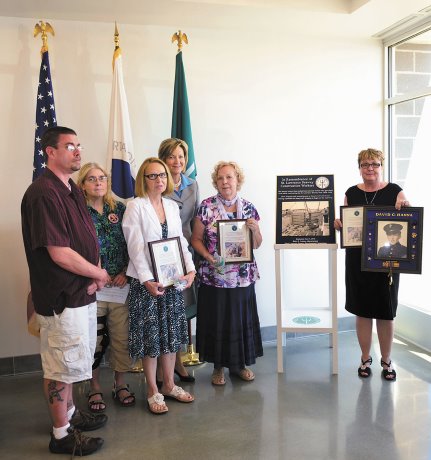Growing up, Bonnie Pearson of Ogdensburg, N.Y. says she believed her father was the only construction worker who died while working on the St. Lawrence Seaway project.
She now knows she wasn’t alone, following the recent dedication of a workers’ memorial plaque at the Saint Lawrence Seaway Development Corporation’s (SLSDC) Dwight D. Eisenhower Visitors’ Center in nearby Massena, N.Y.
In 1955, her father, David Hanna, was working on the St. Lawrence Power Project in Massena dredging sand when he was crushed by a malfunctioning bucket of the massive crane he was operating. The Second World War veteran died in hospital shortly after at age 37 and was believed to be the first worker to have died while building the project.
"I was just 13 at the time, but for years my four sisters and I would talk about my poor dad who died just a few minutes after my mother could get to him in the hospital," says Pearson. "It was a terrible thing to go through."
Almost three years ago, Pearson’s daughter gave her a copy of The St. Lawrence Seaway and Power Project, An Oral History of the Greatest Construction Show on Earth by Claire Puccia Parham. The book chronicles the massive construction effort of 22,000 people on both sides of the border to build the Seaway from 1955 to 1959.
"There was one specific chapter where people who had worked on the Seaway told their stories about the men killed in the project," says Pearson. "Men were decapitated, electrocuted and had cement poured over them and they were never able to get them out. Many were also injured. My sisters and I had never heard any of that. I read it and I cried about these terribly brave men and the dangers they faced. Nobody really knows how many workers died and some of the bodies were never recovered."
Pearson began to petition anyone who would help her fulfill her goal, speaking to people from Massena, to state capital Albany, to Washington, D.C. She found a fellow traveller in Joe Walker, security chief at the visitors’ center. Ultimately, Betty Sutton, administrator at the SLSDC, which operates the American side of the Seaway, agreed to create a memorial and dedicate it at a service for fallen workers.
"Almost 60 years have passed and many of the people who had worked on the construction project had already died and I wanted to make sure everybody remembered the fallen workers and that I could get it done before I died," says Pearson.
An outreach program was conducted by the SLSDC to identify and invite as many Seaway construction workers as possible to the June 3 event. Pearson says enough people and their families attended the service that many listened to the service from outside the main room.
"To think that construction of the joint Seaway and power projects began in 1954 and that the Seaway opened to deep draft navigation just five short years later, in 1959, is a tribute to those people whose extraordinary efforts made this possible, particularly under the extreme conditions they faced," said Tom Lavigne, SLSDC’s associate administrator, at the service.
For Pearson, who spoke at the event, the recognition for Seaway workers was a bittersweet experience.
"I was just so thankful that they were going to do something," she says. "But it was very emotional. The memorial plaque looked nice, but it also raised a lot of sad memories."





Recent Comments
comments for this post are closed